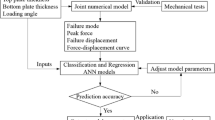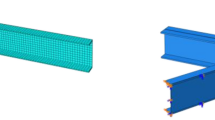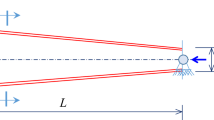Abstract
Machine parts always work under different types of stresses or loading conditions. The sudden dimensional changes lead to sudden increase in stress on the critical section of the machine parts. This state is defined as stress concentration factor (SCF). The strength of the machine part decreases on the located point at maximum stress. In this study, SCFs of circular/elliptical holes with bead reinforcement in an infinite panel under uniaxial and biaxial stresses were modeled, simulated, calculated and verified using analytical, finite element analysis (FEA) and artificial neural networks (ANN) techniques. This study presents a new model for predicting SCF for panels using artificial intelligence techniques under uniaxial and biaxial loading conditions. Theoretical SCF (Kt) values for different shapes and loading conditions have been compiled and graphical forms of these experimental results were published by Peterson (Peterson’s stress concentration factors, 3rd edn. Wiley, Hoboken, 2007). There is a need to convert these curves into a numerical data set to be used in machine part design easily. Theoretical SCF (Kt) was obtained from the Peterson’s charts in numerical form according to dimensional parameter ratios using high-accuracy graphical computer software. Using these dimensional parameter ratios, a parametric finite element model (FEM) was created. Uniaxial and biaxial boundary conditions were applied to the FEM model. Mesh optimization was accomplished to the parametric FEM model. Mesh formation is compatible with the model according to dimensional sizes and ratios. Mesh optimization was provided to element size and per unit volume. Numerical and FEA results were tested, approved and confirmed with Peterson’s original data using statistical methods. A code was created for the improvement of the ANN model in the Matlab ANN Toolbox Editor. Different ANN model variations were tested and the best-performing ANN model was determined among the tried models. Numerical, FEA and ANN model results were compared and confirmed with one another. The developed model provides an easy method to predict and calculate the stress in defining the Kt according to dimensional ratios and applied loading states (uniaxial/biaxial).


















Similar content being viewed by others
Abbreviations
- \(\emptyset\) :
-
Real stress function
- \(\nu\) :
-
Poisson ratio
- a :
-
Inner radius of the circle/ellipse hole
- a 1 :
-
Major axes of the elliptical hole with bead reinforcement
- b :
-
Outer radius of the reinforcement hole
- b 1 :
-
Minor axes of the elliptical hole with bead reinforcement
- x :
-
Thickness of the bead reinforcement
- n :
-
m Ratio of thickness reinforcement to the thickness of the plate
- h :
-
Thickness of the panel
- ht :
-
Thickness of the bead reinforcement
- Q :
-
Equivalent stress
- K :
-
Stress concentration factor
- Kt :
-
Theoretical stress concentration factor for normal stress
- q :
-
Notch sensitivity factor
- σ x, σ y, τ xy :
-
Stress components
- σ θ, σ r, τ rθ :
-
Stress components
- σ y :
-
Yield strength stress components
- \({\text{Net }}O\) :
-
ANN result
- \(w_{i,j}\) :
-
Weights of each layer
- \(x_{k}\) :
-
Input variable of the layers
- \(b_{m}\) :
-
Bias variable of each layer
- \(v_{m,n}\) :
-
Weight of the bias variable of each layer
- P :
-
Number of experiments
- t j :
-
Numerical result of jth element
- o j :
-
ANN result of jth element
- RMSE:
-
Root mean square error
- R 2 :
-
Coefficient of determination
- MEP%:
-
Mean error percentage
References
Pilkey WD, Pilkey DF (2007) Peterson’s stress concentration factors, 3rd edn. Wiley, Hoboken
Muskhelishvili NI (1965) Some basic problems of the mathematical theory of elasticity. In: Proceedings of the IUTAM Symposium on Tbilisi. pp 56–75
Savin GN (1970) Stress concentration around holes. National Aeronautics and Space Administration, Washington, DC
Lekhnitskii SG (1963) Theory of elasticity of an anisotropic elastic body. Holden-Day Inc, San Francisco
Ukadgaonker VG, Rao DKN (1999) Stress distribution around triangular holes in anisotropic plates. Compos Struct 45(3):171–183. https://doi.org/10.1016/S0263-8223(99)00024-0
Sharma DS (2011) Stress concentration around circular/elliptical/triangular cutouts in infinite composite plate. In: Proceedings of the world congress on engineering, 3, July 6–8, London, UK.
Karakılçık S, Özbay M, Adin H (2016) The investigation of the stress concentration in composite plates with a circular hole. Dicle Univ J Eng 1:113–128
Pierce DN, Chou SI (1973) Stresses around elliptic holes in circular cylindrical shells. Exp Mech 13:487–492. https://doi.org/10.1007/BF02322735
Badr EA, Yousef N (2009) Investigatıon of pressure stress concentration factors for intersecting elliptic bores with circular bores in blocks. In: Proceedings of the ASME pressure vessels and piping proceedings of PVP2009, July 26–30, Prague, Czech Republic
Houghton DS, Rothwell A (1961) The analysis of reinforced circular and elliptical cut outs under various loading conditions. The College of Aeronautics Cranfield report no: 151
Durelli AJ, Parks VJ, Feng HC (1966) Stress around an elliptical hole in a finite plate subjected to axial loading. J Appl Mech 33(1):192–195. https://doi.org/10.1115/1.3624979
Luo L, Xiang Y, Qz W (2012) Stress concentration factor expression for tension strip with eccentric elliptical hole. Appl Math Mech Engl Ed 33:117–128. https://doi.org/10.1007/s10483-012-1537-7
Khaja AA, Rowlands RE (2013) Experimentally determined stresses associated with elliptical holes using polar coordinates. Strain 49(2):116–124. https://doi.org/10.1111/str.12018
Hanus JB, Burger CP (1981) Stress–concentration factors for elliptical holes near an edge. Exp Mech 21:336–340. https://doi.org/10.1007/BF02326233
She C, Guo W (2007) Three-dimensional stress concentrations at elliptic holes in elastic isotropic plates subjected to tensile stress. Int J Fatigue 29(2):330–335. https://doi.org/10.1016/j.ijfatigue.2006.03.012
Wang H, Qin QH (2012) A new special element for stress concentration analysis of a plate with elliptical holes. Acta Mech 223:1323–1340. https://doi.org/10.1007/s00707-012-0650-z
Ozkan MT, Kaygısız M (2016) The definition and prediction of stress analysis of plates with elliptical hole by artificial neural networks. Gazi Univ J Sci 4:135–145
Enab TA (2014) Stress concentration analysis in functionally graded plates with elliptic holes under biaxial loadings. Ain Shams Eng J 5(3):839–850. https://doi.org/10.1016/j.asej.2014.03.002
Yang L, Zhu H, Tan D (2012) Influence of soft filler on stress concentration factor of elliptic holes in a rectangular plate. Trans Tianjin Univ 18:117–120. https://doi.org/10.1007/s12209-012-1614-z
Yang Z (2009) The stress and strain concentrations of an elliptical hole in an elastic plate of finite thickness subjected to tensile stress. Int J Fract 155:43–54. https://doi.org/10.1007/s10704-009-9320-0
ANSYS 2019R1 WINX64 (Gazi University)
Matlab 2018b (Gazi University)
Mahmud S, Wissam M (2013) Introduction to ANSYS workbench. Aviation College, Aerospace and Academic Studies
Bhavikatti SS (2005) Finite element analysis. New Age International (P) Limited, Publishers, New Delhi ISBN (13): 978-81-224-2524-6
Moatamedi M, Khawaja H (2018) Finite element analysis. CRC Press, Taylor & Francis Group, New York. ISBN: 978-32073-4
Moaveni S (2015) Finite element analysis theory and application with ANSYS, 4th edn. Pearson, New York. ISBN 10: 0-273-77430-1
Dechaumphai P, Sucharitpwatskul S (2018) Finite element analysis with ANSYS workbench. Alpha Science International Ltd. Oxford. ISBN 978-1-78332-369-2
Altabey WA, Noori M, Wang L (2018) Using ANSYS for finite element analysis a tutorial for engineers volume I. Momentum Press Engineering, New York. ISBN-13: 978-1-94708-320-2
Haykin S Neural networks: a comprehensive foundation subsequent edition. ISBN-13: 978-0132733502; ISBN-10: 0132733501
Haykin S (2008) Neural networks and learning machines, 3rd edn. McMaster University Hamilton, Ontario. ISBN-13: 978-0131471399; ISBN-10: 0131471392
Domany E, Hemmen JL, Schulten K (eds) (1995) Models of neural networks II. Springer, New York. ISBN-13:978-1-4612-8736-0.
Marquardt D (1963) An algorithm for least-squares estimation of nonlinear parameters. SIAM J Appl Math 11(2):431–441. https://doi.org/10.1137/0111030
Hagan MT, Menhaj M (1994) Training feed-forward networks with the Marquardt algorithm. IEEE Trans Neural Netw 5(6):989–993. https://doi.org/10.1109/72.329697
Hagan MT, Demuth HB, Beale MH (1996) Neural network design. PWS Publishing, Boston
Beale MH, Martin TH, Demufh HB (2018) Neural network toolbox1” User's guide R2018a. MathWorks, Inc.
Beale MH, Martin TH and Demufh HB (2016) Neural Network Toolbox™ Getting Started Guide 2016 a. The MathWorks, Inc.
Demuth H, Beale M (2002) Neural network toolbox for MATLAB. The MathWorks, Inc. ISBN-10/ASIN: B0006P1NU0
Smith J (2017) Neural network architectures. Examples using MATLAB
Rosenblatt J (2002) Basic statistical methods and models for the sciences. Chapman and Hall/CRC Press, Boca Raton, London, New York
Werbos PJ (1974) Beyond regression: new tools for prediction and analysis in the behavioral sciences. Ph.d., thesis, Harvard University Cambridge, Massachusetts
Perez C (2019) Statistics and data analysis with Matlab. Cluster analysis and pattern recognition with neural networks. KDP Print US
Ulas HB, Ozkan MT, Malkoc Y (2019) Vibration prediction in drilling processes with HSS and carbide drill bit by means of artificial neural networks. Neural Comput Appl 31:5547–5562. https://doi.org/10.1007/s00521-018-3379-3
Ulas HB, Ozkan MT (2019) Turning processes investigation of materials austenitic, martensitic and duplex stainless steels and prediction of cutting forces using artificial neural network (ANN) techniques. Indian J Eng Mater Sciences (IJEMS) 26(2):93–104
Ozkan MT, Erdemir F (2020) Determination of stress concentration factors for shafts under tension. Mater Test 62(4):413–421. https://doi.org/10.3139/120.111500
Kurt A, Bakir S (2020) Theoretical analysis and mathematical modeling of deformation and stresses of the grooving tool. Neural Comput Appl 32:10481–10500. https://doi.org/10.1007/s00521-019-04588-w
Author information
Authors and Affiliations
Corresponding author
Ethics declarations
Conflict of interest
The authors whose names are listed immediately below certify that they have no affiliations with or involvement in any organization or entity with any financial interest (such as honoraria; educational grants; participation in speakers’ bureaus; membership, employment, consultancies, stock ownership or other equity interest; and expert testimony or patent-licensing arrangements) or non-financial interest (such as personal or professional relationships, affiliations, knowledge or beliefs) in the subject matter or materials discussed in this manuscript.
Additional information
Publisher's Note
Springer Nature remains neutral with regard to jurisdictional claims in published maps and institutional affiliations.
Rights and permissions
About this article
Cite this article
Ozkan, M.T., Erdemir, F. Determination of theoretical stress concentration factor for circular/elliptical holes with reinforcement using analytical, finite element method and artificial neural network techniques. Neural Comput & Applic 33, 12641–12659 (2021). https://doi.org/10.1007/s00521-021-05914-x
Received:
Accepted:
Published:
Issue Date:
DOI: https://doi.org/10.1007/s00521-021-05914-x




